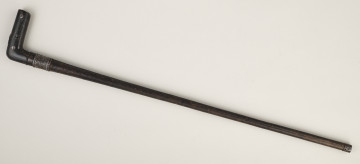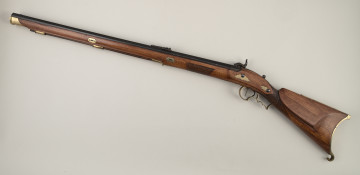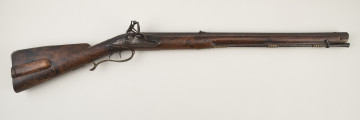
Shooting stick
20th century
Castle Museum in Łańcut
Part of the collection: Broń, instrumenty, varia
The arrival of powder on battlefields marked the beginning of a further „arms race”; work commenced on new rifles; calibres were changed to find the one most suited to counter the armour that was still in use; weights were changed so that one could fire when mounted; ever more precise aiming equipment was used, and muzzles started to be threaded. One of the more important element that, so to speak, allowed efficient combat irrespective of the weather conditions and individual training, was the development of a failsafe lock. The first match locks were very sensitive to weather conditions; wheellocks were expensive, complicated and required professional handling; it was only the introduction of the flint lock that allowed full use of firearms by infantry and (mounted) cavalry. The operation of this type of lock boils down to making sparks through the impact of the flint against a steel component on the lock. Over the course of one and a half century when the flintlock triumphed, many versions emerged (with the general rule of operation remaining unchanged), e. g. the snaphance, the miquelet lock, the battery (French lock), the Scandinavian flint lock, etc. The idea behind these locks basically boils down to the placement of a small stone (flint) in the cock; this flint (after the tension is released by the trigger), when impacting the frizzen, made sparks and caused the powder on the pan to ignite, with the flame reaching the chamber via the touchhole, where the main powder charge ignites. This type of lock is used by the sharpshooter flint rifle found in the collection of the museum. It was made around the year 1780 in Prussia, and bears (on the lock) the marks of the royal arsenal of Prussia. The muzzle is 675 mm in length and has eight threads. The handguard is made of nut wood, brown, and has two brass sleeves for the placing of the ramrod; the butt itself is elongated with its sides barely marked. The introduction of the caplock mechanism into weaponry made the use of weapons almost entirely independent of the weather conditions; it also simplified firing and improved the efficiency of firearms.
Author / creator
Dimensions
height: 107 cm, width: 18 cm
Object type
Weapons, instruments, varia
Technique
metallurgical
Material
wood, steel
Creation time / dating
Creation / finding place
Owner
Castle Museum in Łańcut
Identification number
Location / status

20th century
Castle Museum in Łańcut

18th century
Castle Museum in Łańcut

18th century
Castle Museum in Łańcut
DISCOVER this TOPIC
Museum of King Jan III's Palace at Wilanów
DISCOVER this PATH
Educational path